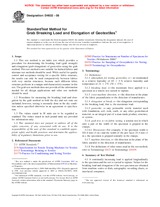Potřebujeme váš souhlas k využití jednotlivých dat, aby se vám mimo jiné mohly ukazovat informace týkající se vašich zájmů. Souhlas udělíte kliknutím na tlačítko „OK“.
ASTM D4632-08
Standard Test Method for Grab Breaking Load and Elongation of Geotextiles
Automaticky přeložený název:
Standardní zkušební metoda pro Grab mez pevnosti a tažnost geotextilií
NORMA vydána dne 1.7.2008
Informace o normě:
Označení normy: ASTM D4632-08
Poznámka: NEPLATNÁ
Datum vydání normy: 1.7.2008
Kód zboží: NS-27961
Počet stran: 4
Přibližná hmotnost: 12 g (0.03 liber)
Země: Americká technická norma
Kategorie: Technické normy ASTM
Anotace textu normy ASTM D4632-08 :
Keywords:
Breaking strength/tenacity, Elongation--geotextiles, Geosynthetics, Grab test, Strength--geosynthetics, Tensile properties/testing--geosynthetics, ICS Number Code 59.080.70 (Geotextiles)
Doplňující informace
| Significance and Use | ||||||||||||
|
The grab method is applicable whenever it is desired to determine the “effective strength” of the fabric in use, that is, the strength of the material in a specific width, together with the additional strength contributed by adjacent material. There is no simple relationship between grab tests and strip tests since the amount of fabric assistance depends on the construction of the fabric. It is useful as a quality control or acceptance test. The procedure in Test Method D 4632 for the determination of grab strength of geotextiles may be used for acceptance testing of commercial shipments, but caution is advised since information about between-laboratory precision is incomplete. Comparative tests as directed in 5.2.1 are advisable. In case of a dispute arising from differences in reported test results when using the procedures in Test Method D 4632 for acceptance testing of commercial shipments, the purchaser and the manufacturer should conduct comparative tests to determine if there is a statistical bias between their laboratories. Competent statistical assistance is recommended for the investigation of bias. As a minimum, the two parties should take a group of test specimens that are as homogeneous as possible and which are from a lot of material of the type in question. The test specimens should then be randomly assigned in equal numbers to each laboratory for testing. The average results from the two laboratories should be compared using the appropriate Student's t-test and an acceptable probability level chosen by the two parties before testing is begun. If a bias is found, either its cause must be found and corrected or the purchaser and the manufacturer must agree to interpret future test results in the light of the known bias. Most geotextile fabrics can be tested by this test method. Some modification of clamping techniques may be necessary for a given fabric, depending upon its structure. Special adaptation may be necessary with strong fabrics, or fabrics made from glass fibers, to prevent them from slipping in the clamps or being damaged as a result of being gripped in the clamps, such as cushioning the clamp or boarding the specimen within the clamp. This test method is applicable for testing fabrics either dry or wet. It may be used with constant-rate-of-traverse (CRT) or constant-rate-of-extension (CRE) type tension machines. However, there may be no overall correlation between the results obtained with the CRT machine and the CRE machine. Consequently, these two tension testers cannot be used interchangeably. In case of controversy, the CRE machine shall prevail. |
||||||||||||
| 1. Scope | ||||||||||||
|
1.1 This test method is an index test which provides a procedure for determining the breaking load (grab strength) and elongation (grab elongation) of geotextiles using the grab method. This test method is not suitable for knitted fabrics and alternate test methods should be used. While useful for quality control and acceptance testing for a specific fabric structure, the results can only be used comparatively between fabrics with very similar structures, because each different fabric structure performs in a unique and characteristic manner in this test. The grab test methods does not provide all the information needed for all design applications and other test methods should be used. 1.2 Procedures for measuring the breaking load and elongation by the grab method in both the dry and wet state are included; however, testing is normally done in the dry condition unless specified otherwise in an agreement or specification. 1.3 The values stated in SI units are to be regarded as standard. The values stated in inch-pound units are provided for information only. 1.4 This standard does not purport to address all of the safety concerns, if any, associated with its use. It is the responsibility of the user of this standard to establish appropriate safety and health practices and determine the applicability of regulatory limitations prior to use. |
||||||||||||
| 2. Referenced Documents | ||||||||||||
|




 Cookies
Cookies
